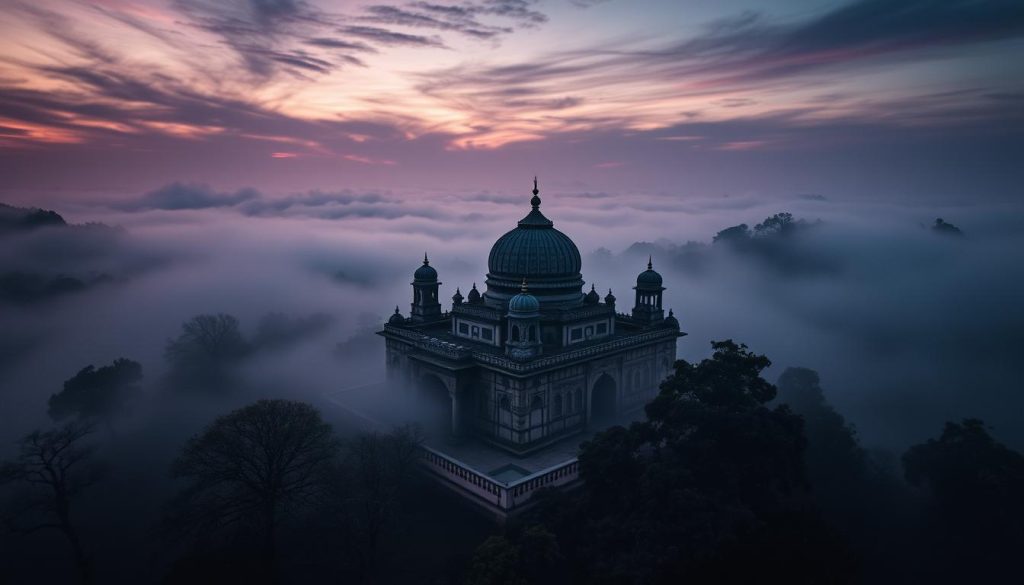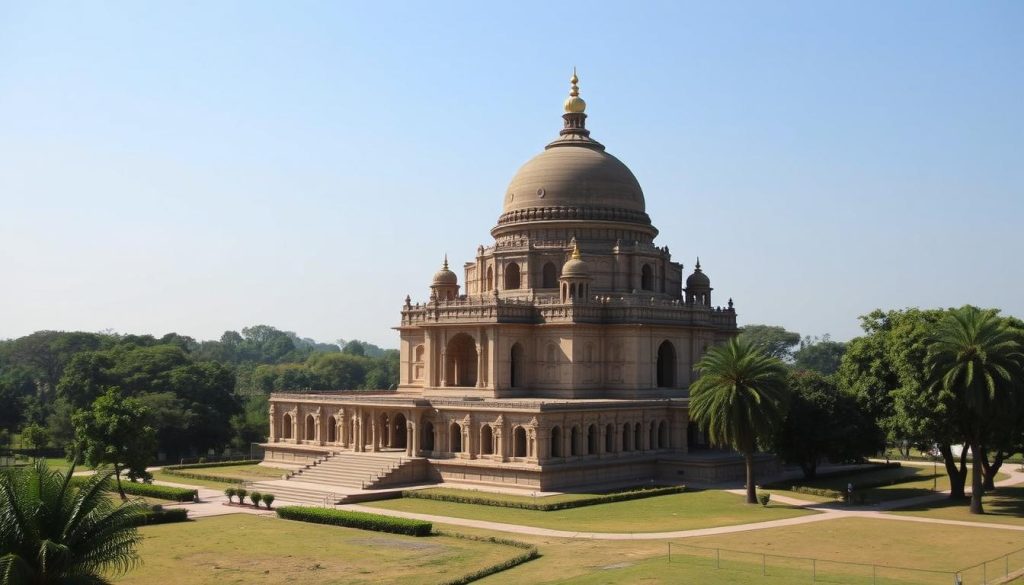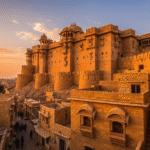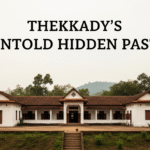The Gol Gumbaz in Bijapur has the second-largest dome in the world. It competes with St. Peter’s Basilica in Rome with a 44-meter span. Built in the 17th century, it shows Deccan Sultanate heritage. However, it also keeps secrets of an unfinished story due to Adil Shah’s early death in 1656. Its whispering gallery is a wonder where whispers echo up to 10 times, making soft sounds louder.
The monument has many hidden stories. It shows the rich past of a dynasty that ruled with style. These secrets interest historians, architects, and travelers. They come to see ancient craftsmanship and hear old tales. The journey to these stories starts in the mausoleum’s galleries. They guard the Sultan, his family, and their impact on Indian architecture.
To really see this building’s beauty, one must learn about the Adil Shahi dynasty’s power. This trip is like going back in time. It helps you dive into the Deccan Sultanate heritage that shaped South India. The Gol Gumbaz is not just a building. It connects people to the stories and traditions of the past.
Key Takeaways
- Imposing at 44 meters, Gol Gumbaz’s dome is the second largest in the world, right after St. Peter’s Basilica.
- The whispering gallery’s acoustic properties allow even hushed whispers to echo across the grand expanse.
- An emblem of Bijapur’s historical canvas, Gol Gumbaz is steeped in the Deccan Sultanate heritage.
- Visitors can bask in a spectrum of local experiences, from culinary delights to artisan visits, adding depth to their exploration.
- Designed as Muhammad Adil Shah’s tomb, the monument is an architectural tour de force worthy of in-depth study and appreciation.
- Peak visitation periods span the cooler months, from October to February, providing the ideal climate to delve into the region’s past.
The Echoing Enigma of Bijapur’s Dome
Bijapur’s Dome, also known as Gol Gumbaz, is a marvel in India. It shows off the area’s history and sound mastery. This spot is where Sultan Mohammed Adil Shah rests. It’s famous for sonic surprises too.
The Whispering Gallery and Sonic Surprises
The Whispering Gallery inside Gol Gumbaz is amazing. Even the softest whispers or footsteps can be heard clearly over 130 feet away. This pulls in both tourists and sound experts. They come to hear sounds travel far and clear because of the design.
At the Whispering Gallery, sounds are not just heard. They echo around seven times before fading out. It shows how special the dome’s sounds are.
Architectural Acoustics and Accidental Discoveries
People often wonder how such special architectural acoustics were made back in 1656. The design uses dark gray basalt. It also has a clever dome shape without pillars. This lets sound move freely and reach far across the room.
More discoveries about the dome and sound came up by chance. Experts were checking the dome and found out new things. The measurements and design were very precise for its time.
In short, Bijapur’s Dome amazes everyone not just by how it looks. It also has special sounds. Lots of people visit to experience these architectural acoustics. These sounds were created way ahead of their time.
The Legacy of the Deccan Sultanate at Gol Gumbaz
The Gol Gumbaz in Bijapur is a jewel of Indian history. It’s not just beautiful but also a deep symbol of Deccan Sultanate’s legacy. Built by the Adil Shahi Dynasty, it stands as a peak of Indo-Islamic craft. It also shows amazing building innovations.
Intriguing Tombs and Their Inhabitants
Inside Gol Gumbaz, there are tombs of Sultan Muhammad Adil Shah and his family. This place is very important for those who love Deccan Sultanate history. The tomb’s large dome is the world’s second-largest, measuring 44 meters. It reflects the Sultanate’s architectural style.
Adil Shahi Dynasty’s Imprint on Indian Architecture
Gol Gumbaz’s design mixes many cultural styles thanks to the Adil Shahi Dynasty. Inside the dome, there’s a whispering gallery. Here, even quiet whispers are heard from 38 meters away. This feature shows the cleverness of its builders. The museum here also displays items that tell us about the Adil Shahi era. These artifacts give clues about the lifestyle and governance of that time.
Learning about Gol Gumbaz and the Adil Shahi Dynasty deepens our love for India’s Deccan Sultanate heritage. Each visit gives us a newer understanding of the history that shapes the region. It also influences today’s architecture and culture.
Hidden Tales of Gol Gumbaz: The Unsung Chronicles
Gol Gumbaz has stories that go beyond its beauty. It sits in Bijapur, holding many untold stories. These stories are about the past and power of the Deccan sultanates in India.
Every part of Gol Gumbaz shares a piece of its secret past. The dome talks about hidden meetings. The walls could tell tales of secret court dramas. These stories help us know the culture when the Adil Shahi dynasty ruled.
Understanding these stories helps us see why things were built a certain way. It shows how power and society were organized in the kingdom.
To truly find these unsung chronicles, visitors need to look closely. Notice the small carvings, window placements, and fancy corridors. Each tells a part of the monument’s secret history.
The monument stands for power and the many people who lived there. Stories range from soldiers to sultans. Each story adds to the monument’s rich history.
| Feature | Description | Historical Significance |
|---|---|---|
| Central Dome | Majestic dome standing at 51 meters in diameter | Craftsmanship showcasing the ingenuity of Adil Shahi architects, intended for acoustic magnificence |
| Whispering Gallery | A circular gallery where even the softest whisper can be heard clearly on the opposite side, thanks to its unique acoustics. | Strategic positioning used for eavesdropping during council meetings, indicating the layers of secrecy that surrounded the sultanate’s governance |
| Corner Minarets | Four imposing minarets housing staircases | Served both functional and ceremonial purposes, symbolizing the Islamic influence on the region’s architecture and governance |
The story of Gol Gumbaz is more than just history. It’s a collection of hidden tales of Gol Gumbaz and secrets. It shows us lives that shaped its splendor. As we uncover these stories, Gol Gumbaz shares the human story of that time.
Secret Chambers and Concealed Passageways
The majestic Gol Gumbaz is very intriguing. It has a unique design and is quite old. It has long been thought to hide secret chambers and passageways. People love these mysteries.
Clandestine Structures Embedded in the Walls
Gol Gumbaz’s design hints at secrets. Historians think it might have hidden rooms. These could have kept treasures safe or been hideouts.
So far, no one has found these secret rooms. But the search continues. This makes Gol Gumbaz an exciting mystery to explore.
The Mystery of Sealed Entrances: Fact or Fiction?
Sealed entrances at Gol Gumbaz add to its mystery. They could be old hidden paths. Or maybe just design mistakes.
These secrets make Gol Gumbaz very interesting. They show us how rich India’s history is. There could be many stories hidden there.
Exploring Gol Gumbaz’s mysteries is thrilling. It helps us learn more about history. Every hidden path or room might reveal new secrets.
Gol Gumbaz’s Design: An Architectural Marvel of the Deccan
The iconic Gol Gumbaz is a masterpiece of Deccan architectural marvel. It shows the engineering proficiency of its era. With its huge dome and detailed art, it impresses architects and historians everywhere.
Engineering Proficiency in Heritage Construction
Gol Gumbaz’s structure is a top example of engineering proficiency from its time. Its large dome has no pillars for support. This shows major engineering skill and heritage building techniques from the Deccan Sultanate.
Yali’s Balconies: A Synthesis of Mythology and Art
Yali’s balconies are a key feature of Gol Gumbaz. They mix mythology and art beautifully. These balconies have Yali sculptures, a mythical figure in Hindu temples. They show Deccan architecture’s mix of culture.
In summary, Gol Gumbaz is more than an old building. It’s an important part of Deccan’s architectural story. Its beauty and strong structure are great examples of heritage construction. They keep inspiring many.
Mysterious Legends of Gol Gumbaz
The Gol Gumbaz in Karnataka, India, is full of cultural heritage and mysterious legends. This grand tomb belongs to Sultan Mohammed Adil Shah. It’s an architectural wonder filled with old stories.
Mysterious legends of Gol Gumbaz tell about its dome. Here, a whisper can travel across the hall. This adds to the mystery of this historical place. It’s a key part of India’s cultural heritage.
History and myths mix at Gol Gumbaz. Legends say the shadows of four minarets protect the tomb from evil spirits. This story is both chilling and fascinating.

Tales of hidden treasures and secret passages are also popular. They add allure and mystery to Gol Gumbaz. These mysterious legends help us understand India’s cultural heritage. They show the historical and mystical elements of this region.
To truly appreciate Gol Gumbaz, let’s compare it with other monumental sites in India. They also blend history with mysteries, enriching India’s heritage.
| Monument | Construction Period | Unique Feature |
|---|---|---|
| Taj Mahal | 1632-1653 | Inlaid with 28 types of semi-precious stones |
| Ajanta Caves | 2nd Century BCE – 650 CE | 30 rock-cut Buddhist cave monuments |
| Ellora Caves | 350-700 AD | 34 caves with Buddhist, Jain, and Hindu temples |
| Meenakshi Amman Temple | Reconstructed in the 17th century | Spread across 45 acres |
| Konark Sun Temple | 13th century AD | Chariot-like architecture with intricate stone carvings |
Like Gol Gumbaz, these sites have their unique stories and secrets. They are all important to India’s cultural heritage.
Gol Gumbaz: A Must-Visit Destination for History Buffs
Steeped in historical significance, Gol Gumbaz is a treasure for anyone interested in India’s history. It is a breathtaking mausoleum from the Deccan Sultanate era. It offers a peek into the past.
Gol Gumbaz draws in those who love history and architecture. It has a special gallery where whispers can be heard across the dome. This place is a mix of history, culture, and science.
- Explore the echo phenomenon unique to this architectural giant.
- View intricate carvings that detail the artistry of the period.
- Unravel the stories of the rulers who are eternally entombed within its walls.
The town of Bijapur has lots more history to explore, with forts and mosques. It shows the Islamic impact on medieval Indian architecture.
Visiting Gol Gumbaz is an unforgettable adventure. It’s not just about its historical significance. It shows why it’s a must-visit destination.
The Historical Tapestry of Vijayanagara Empire and Gol Gumbaz
South India’s history is filled with grand empires and stunning buildings. The Vijayanagara Empire and Gol Gumbaz in Bijapur are key highlights. They show how politics and building design are linked. This draws both scholars and tourists to learn more about their stories.
Visiting Hampi’s Vijayanagara Empire and Gol Gumbaz tells us a lot. It shows India’s culture and history. These places show the skill and power of their creators. They also show their spiritual meaning.
These famous spots are part of many learning trips. Tour packages often include them. This gives travelers a full picture of their history.
Tour Details and Travel Opportunities in Relation to these Historical Sites:
| Feature | Description |
|---|---|
| Travel Route | Hubli, Hampi, Bijapur, Badami, Goa Beach |
| Price Overview | Starting at approximately 870 GBP |
| Accommodation & Meals | Inclusive of 15 nights stay and breakfasts |
| Best Visiting Time for Hampi | April – Favorable weather conditions |
| Special Services | Private transportation, sightseeing guides and monument entry included |
| Cancellation Policy | Full refund up to 6 days before the tour |
These tours help people learn about history and boost local tourism. They link historical care with today’s economy. Each visit supports conservation. It also offers a deep dive into the Vijayanagara Empire’s story and Gol Gumbaz’s design.

Ancient Secrets of Gol Gumbaz’s Construction Unearthed
Gol Gumbaz in Bijapur reveals its ancient secrets. It shows the construction techniques of long ago. Its huge dome reaches an external diameter of nearly 45 meters.
Gol Gumbaz stands as a sign of the architectural dream of 17th-century India. It was built under Mohammed Adil Shah’s rule, from 1627 to 1656. This made it a key landmark, showing off Karnataka’s cultural history.
The Use of Transitional Architectural Techniques
The construction techniques of Gol Gumbaz are amazing. Its huge hemispherical dome is second in size only to St. Peter’s Basilica. The structure’s square base and massive dome are supported by pendentives and buttresses.
This was a big step forward in building at that time. The whispering gallery, an acoustic wonder, is 32 meters up in the dome. Even whispers can be heard across a wide space – showing a time rich in sound and building experiments.
Material Mysteries: Indigenous vs Imported
A closer look at Gol Gumbaz reveals more than just its size. It talks about the materials used in its building. Its walls of dark grey basalt, with ornate plaster, mix local and maybe foreign materials.
This shows a time of cultural exchange and artistic blending within the Deccan Sultanate. They used brick and lime, choosing stuff that was easy to find. The addition of elements like domed octagonal towers shows mixing different building styles.
This mix of local and foreign designs tells a story of Gol Gumbaz. It is seen as a masterpiece across cultures, slowly shared by scholars and historians.
FAQ
Why is Gol Gumbaz considered an architectural marvel?
The huge dome of Gol Gumbaz stands out because it’s the world’s second-largest. Its Whispering Gallery is special for its sounds. This spot shows the unique building ways of the Deccan Sultanate era.
What is the historical significance of Gol Gumbaz?
Gol Gumbaz is important because it’s where Muhammad Adil Shah, the Sultan of Bijapur, rests. It shows the Deccan Sultanate’s rich culture. And highlights the architecture from the 17th century by the Adil Shahi kings.
What are the hidden tales of Gol Gumbaz?
Gol Gumbaz’s secret tales talk about hidden rooms and mysterious pasts. People and historians share these stories. They reveal the ancient conflicts and palace dramas.
Can you hear whispers across Gol Gumbaz’s Whispering Gallery?
Yes, you can hear whispers clear across its Whispering Gallery. The dome’s curve makes this cool sound trick possible.
Are there any secret chambers in Gol Gumbaz?
People tell stories of hidden chambers in Gol Gumbaz. Sealed doors and odd building parts start these tales. But no one has found real proof of these rooms. They remain a big mystery.
What is the significance of the Deccan Sultanate heritage seen at Gol Gumbaz?
The Deccan Sultanate’s heritage is well shown at Gol Gumbaz. It highlights the Adil Shahi dynasty’s building skills. And shows the region’s history and the artistic growth back then.
What mysterious legends are associated with Gol Gumbaz?
Gol Gumbaz’s mysteries range from its building tales to ruler stories. These legends add to its charm and importance.
Why is Gol Gumbaz a must-visit destination for history buffs?
History lovers must see Gol Gumbaz for its amazing design and sounds. It lets visitors dive into the Deccan Sultanate’s grand history. It celebrates this region’s historical beauty.
What connections exist between the Vijayanagara Empire history and Gol Gumbaz?
The Vijayanagara Empire shows Hindu traditions, while Gol Gumbaz shows Islamic architecture from the Deccan Sultanate. Comparing them gives us different looks at the past.
What ancient construction secrets has Gol Gumbaz revealed?
Gol Gumbaz’s big stone slabs and design secrets support its huge dome. Research shows a mix of local and foreign building ways. This suggests a sharing of ideas and tech in those times.










